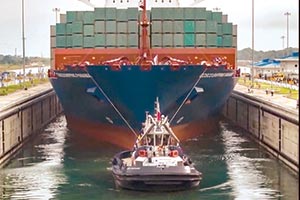Panama Canal Authority Gives First Look at Increased Cargo Following Expansion

This story appears in the Oct. 31 print edition of Transport Topics.
The Panama Canal Authority has disclosed the first cargo statistics that outline the increased activity since the expanded waterway was opened, including 238 transits by Neopanamax vessels that were too large to make the trip in the past.
The authority’s announcement after the Sept. 30 end of its fiscal year said shipments of all types totaled the third-most tonnage ever, led by containerships that accounted for 36% of cargo.
“Despite the international shipping downturn this past year, we recorded one of the highest annual tonnage figures since the opening of the original canal 102 years ago,” Panama Canal Administrator Jorge Quijano said. “This latest success reinforces the continued strategic importance of the route and the growing value that recent investments in the canal will bring to the maritime industry.”
The canal’s transits since the June 26 opening have been watched for signs that cargo movements could be shifting between the U.S. West and East coasts.
Since the $5.25 billion project was completed, ports on the East Coast have heralded the arrival of larger vessels using the expanded Panama Canal. Nationwide, container shipments generally improved last month.
However, there haven’t yet been noticeable Panama Canal-related increases based on port commentary. And railroads that carry that intermodal freight inland haven’t yet noted any shifts, either. Eastern railroads, such as Norfolk Southern Railway, CSX Transportation and Florida East Coast Railway, continue to say they’re prepared for such a shift.
For example, Norfolk Southern Chief Marketing Officer Alan Shaw last week said the railroad continues to strengthen its ties with ocean carriers that intend to increase services on the East Coast.
The Panama Canal uses a measure known as Panama Canal/Universal Measurement System to gauge tonnage, which was 330.7 million in fiscal 2016, trailing the record set in the prior fiscal year.
Containership transits declined nearly 3%, but tonnage they carried was 1.8% higher. Transits of all vessel types totaled 13,114.
In addition to the 238 Neopanamax vessels that already made the transit, 229 reservations have been placed for next year, a spokeswoman said.
“Since opening, the expanded canal has seen major liners redirect service to the waterway,” the statement said. “Nine Neopanamax liner services have been deployed through the new locks, primarily on the U.S. East Coast-to-Asia trade route. Next month, an additional Neopanamax liner service is expected to follow suit.”
The 238 Neopanamax vessels that transited the canal represent about three per day. That activity level to date is about half of the six allocated daily slots for the larger vessels.
Utilization of the expanded canal has drawn industry attention, based on a report issued during the TOC Americas shipping conference earlier this month. Because more cargo can be placed on larger vessels, the number of trips actually is declining, speakers said. TOC stands for the Terminal Operations Conference, which is an industry event tailored to shipping operations.
“What we accomplished with the opening of the expanded Panama Canal this past fiscal year was just the beginning of an ambitious plan to strengthen Panama’s position as the logistics hub of the Americas,” Quijano said.
The Panama Canal Authority also this month requested proposals from four prequalified companies to build and operate the new Corozal Con- tainer Terminal. That term- inal is intended to process at least 5 million industry- standard 20-foot container units annually.
The prequalified companies are APM Terminals, a unit of Danish company A.P. Moller Maersk, which owns the world’s largest container line; Singapore-based PSA International, the world’s largest port operator; the Terminal Link affiliate of France’s CMA CGM, the third-largest ocean carrier; and Terminal Investments Ltd., which is affiliated with No. 2 ocean carrier Mediterranean Shipping Co.

